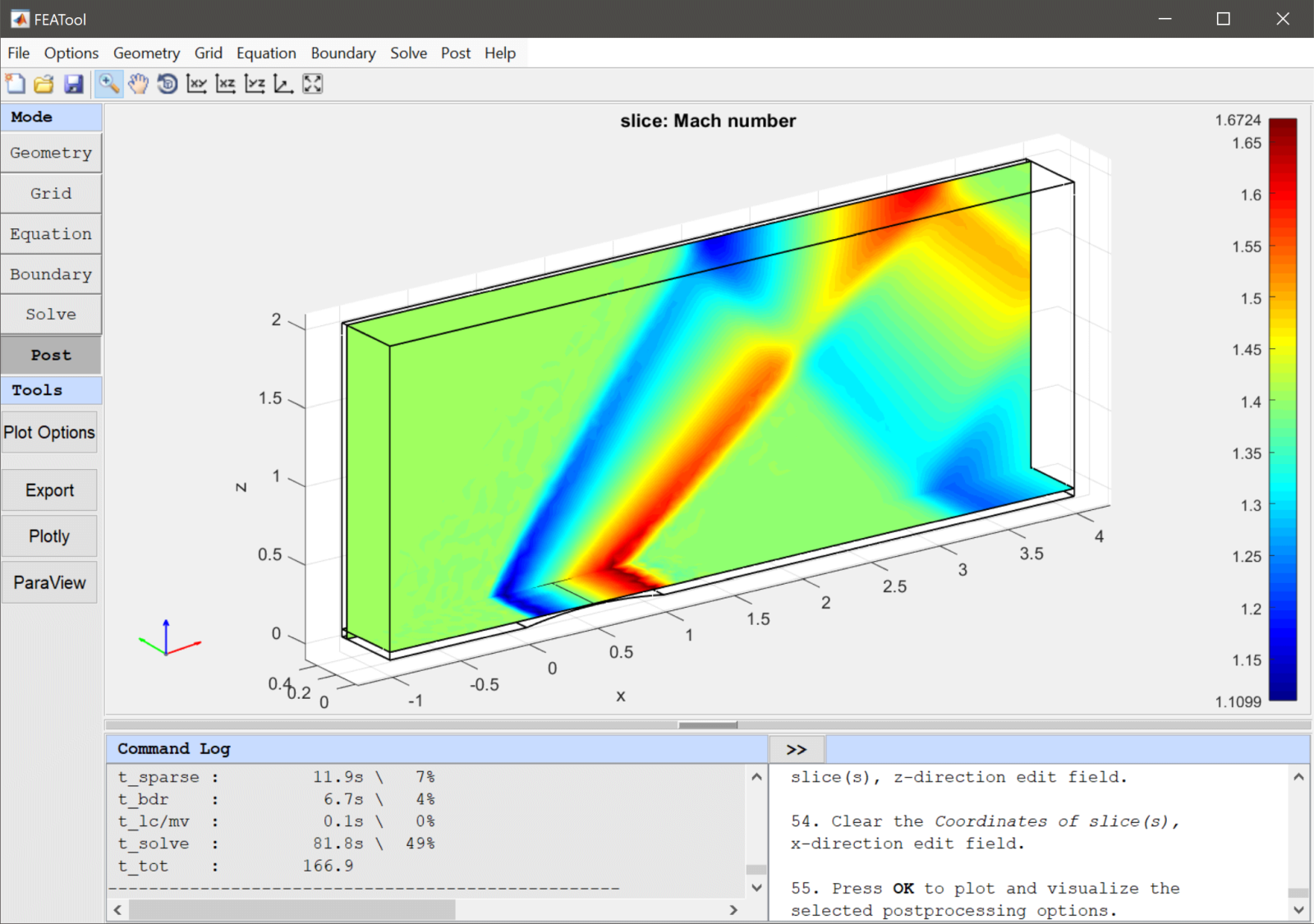 |
FEATool Multiphysics
v1.16.5
Finite Element Analysis Toolbox
|
 |
FEATool Multiphysics
v1.16.5
Finite Element Analysis Toolbox
|
In this example, we simulate three-dimensional supersonic flow through a straight channel with a small obstacle on one wall. The obstacle could represent anything from a protrusion on an aircraft wing to a structural feature in a pipe, like for example in scenarios involving high-speed aircraft or rocket exhausts.
When the high speed flow (Ma = 1.4) impacts the obstacle shock waves are generated and diffracted from both the obstacle and channel walls (that is abrupt and sharp changes in pressure, temperature, and density). This simulation is based on a two-dimensional reference case using the inviscid compressible Euler equations, which has been extensively studied for compressible flow in previous research [1].

This model is available as an automated tutorial by selecting Model Examples and Tutorials... > Fluid Dynamics > Supersonic Flow over an Obstacle from the File menu. Or alternatively, follow the step-by-step instructions below.
Note that the CFDTool interface differ slightly from the FEATool Multiphysics instructions described in the following.
-1 into the xmin edit field.4 into the xmax edit field.0.5 into the ymax edit field.2 into the zmax edit field.0.5 0 0.042-(0.5^2/0.042+0.042)/2 into the center edit field.(0.5^2/0.042+0.042)/2 into the radius1 and radius2 edit fields.0.5 into the length edit field.0 1 0 into the axis edit field.B1-C1 into the Geometry Formula edit field.0.08 into the Grid Size edit field.rho0 into the Initial condition for rho edit field.u0 into the Initial condition for u edit field.v0 into the Initial condition for v edit field.w0 into the Initial condition for w edit field.p0 into the Initial condition for p edit field.| Name | Expression |
|---|---|
| Ma | 1.4 |
| rho0 | 1 |
| p0 | 1 |
| u0 | Ma*sqrt(1.4*p0/rho0) |
| v0 | 0 |
| w0 | 0 |
rho0 into the Density edit field.u0 into the Velocity in x-direction edit field.v0 into the Velocity in y-direction edit field.w0 into the Velocity in z-direction edit field.p0 into the Pressure edit field.30, and decrease the Non-linear relaxation parameter to 1.0, to allow for fastest convergence (no non-linear relaxation).After the problem has been solved FEATool will automatically switch to postprocessing mode and here display the magnitude of the computed velocity field where the shock pattern can easily be seen. Plot the Mach number and verify that the minimum and maximum span between Ma = 1 and 1.8.
0.45 into the Coordinates of slice(s), y-direction edit field.0.05 into the Coordinates of slice(s), z-direction edit field.The supersonic flow over an obstacle fluid dynamics model has now been completed and can be saved as a binary (.fea) model file, or exported as a programmable MATLAB m-script text file (available as the example ex_compressibleeuler5 script file or equivalent ex_compressibleeuler4 in 2D), or GUI script (.fes) file.
[1] Lynn JF, van Leer B, Lee D. Multigrid solution of the euler equations with local preconditioning. In Fifteenth International Conference on Numerical Methods in Fluid Dynamics, Lecture Notes in Physics, vol 490, Springer, 1997.